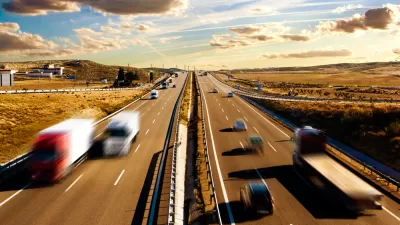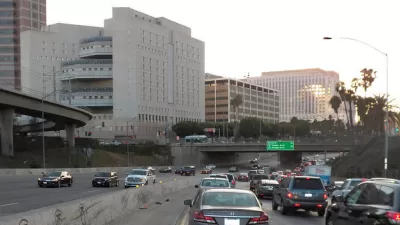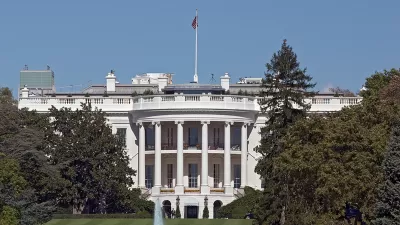On Thursday, the U.S. DOT and U.S. EPA announced one of the Trump administration's most consequential rollbacks of environmental and efficiency regulations that will have a detrimental effect on climate change, air pollution, and oil consumption.
Four months ago, then-EPA Administrator Scott Pruitt announced that current fuel economy standards, finalized by the Obama administration in August 2012, were too strict and should be revised. That revision came August 2, report Brady Dennis, Michael Laris and Juliet Eilperin for The Washington Post:
The Trump administration announced plans Thursday to freeze fuel-efficiency requirements for the nation’s cars and trucks through 2026 — a massive regulatory rollback likely to spur a legal battle with California and other states, as well as create potential upheaval in the nation’s automotive market.
During the White House press briefing that afternoon, White House press secretary Sarah Huckabee Sanders took issue with how she believed the media had reported that joint action taken by the U.S. Environmental Protection Agency and the U.S. Department of Transportation (USDOT), reports Stephanie Murray for POLITICO.
“The reporting that we’re reversing Obama-era fuel efficiency standards in pre-empting the tougher California standards is simply false,” Sanders said. “What the EPA released yesterday was a notice of proposed rule making, not a final rule. The notice lays out a series of options for how to go forward with CAFE standards, and the notice asked for comments on the range of options. We’re simply opening it up for a comment period, and we’ll make a final decision at the end of that.”
"The [proposed] rule would freeze emissions and efficiency standards at 2020 levels, or the equivalent of 43.7 miles per gallon for passenger cars and 31.3 mpg for SUVs and other light trucks," writes Marianne Lavelle for InsideClimate News. Obama's rule called for 54.5 mpg by 2025.
While 54.5 mpg sounds high, automotive experts believe it's more theoretical. In real driving conditions, it "amounts to a figure of 36 mpg Combined on a window sticker," explained Dan Edmonds, Director of Vehicle Testing for Edmonds on the Obama rule. The 2020 standard equates to "an average of 30 mpg in real-world driving" for the vehicle feet, according to the Associated Press.
In a comprehensive analysis, the Rhodium Group calls the proposal "the most environmentally significant regulatory rollback yet," referencing other rollbacks like the Clean Power Plan rule.
Safety justification
The acronym for the proposed rule, SAFE, for Safer Affordable Fuel-Efficient Vehicles Rule for Model Years 2021-2026, stems from USDOT, particularly Deputy Secretary Jeffrey A. Rosen and Heidi King, Deputy Administrator of the National Highway Traffic Safety Administration (NHTSA), according to Coral Davenport of The New York Times.
Mr. Rosen and Ms. King have also justified their proposal with a new [NHTSA] analysis concluding that the stricter Obama-era pollution rules would lead to thousands of deaths in road accidents. They argue that more fuel-efficient cars are less safe because they are lighter.
According to a USDOT/EPA fact sheet [pdf], the proposed will result in "[o]ver 12,000 fewer crash fatalities over the lifetimes of all vehicles built through MY [model year] 2029 [and] up to 1,000 lives saved annually."
In an Aug. 2 op-ed, "Make Cars Great Again," for The Wall Street Journal, partially posted on the White House website, Transportation Secretary Elaine L. Chao and acting EPA Administrator Andrew Wheeler explain the "compelling reasons for a new rulemaking."
The joint proposal lays out eight options [pdf] for new national fuel-economy standards for model years 2021-26...The administration’s proposed option [Alternative #1] would lock in the 2020 standards until 2026, because the analysis of our agencies suggests that those standards strike the appropriate regulatory balance between vehicle improvements, environmental benefits and safety...
Costs
In addition to safety, the other major justification for freezing the rule at the year 2020 is a savings of "$2,340 in overall average vehicle ownership costs for new vehicles" as manufacturers would be spared the expense making vehicles cleaner.
Of course, if the administration was truly concerned with making new vehicles more affordable, it would rethink their trade policies.
According to Reuters on June 26, "[t]he Alliance of Automobile Manufacturers, a group representing General Motors Co, Toyota Motor Corp, Volkswagen AG and other major automakers, will file written comments warning that a 25 percent [tarriff] on imported passenger vehicles would cost American consumers $45 billion annually, or $5,800 per vehicle, spokeswoman Gloria Bergquist said."
Opponents of the new rule also cite cost savings for consumers, but at the pump, not the showroom. Sticking with the 2012 rule "would limit carbon pollution by 6 billion tons, save consumers $1.7 trillion dollars in fuel costs, and reduce oil consumption by up to 4 million barrels every day," claims the Sierra Club.
Calfornia waiver
News leaked on July 23 that Trump would also revoke California's ability to set more rigorous emissions standards. The EPA is proposing to withdraw the California waiver that allows the state with the nation's worst air pollution to set stricter vehicle greenhouse gas emission standards, a provision of the 1970 federal Clean Air Act. According to the fact sheet (pdf):
EPA is proposing to withdraw the January 9, 2013 waiver of CAA preemption for California’s Advanced Clean Car (ACC) program, Zero Emissions Vehicle (ZEV) mandate, and Greenhouse Gas (GHG) standards [aka Pavley Standards] that are applicable to model years 2021 through 2025.
"California has already sued the administration to preserve a single national vehicle emissions standard [i.e., the 2012 standard], and within hours of the Trump administration’s long-anticipated announcement that it would seek to block California from enacting tougher rules, Attorney General Xavier Becerra announced he would lead 19 state attorneys general in a new lawsuit," report Jeremy B. White and Carla Marinucci for POLITICO.
See statements [pdf] from the attorneys general of Connecticut, District of Columbia, Maryland, Virginia, and New Jersey. Some describe how their states are already being impacted by climate change in the form of flooding due in part to sea level rise and extreme weather, as well as air pollution.
Twelve states, known as Section 177 States, have adopted California's more rigorous emissions standards, comprising about one-third of the U.S. auto market.
Electric vehicles
As noted above, withdrawing California's clean air waiver also eliminates its mandate on sales of zero-emission vehicles (ZEVs), comprised of battery electric and fuel cell vehicles. In January, Gov. Jerry Brown (D) called for 5 million ZEVs by 2030, a jump from a prior executive order setting the goal at 1.5 million ZEVs by 2025.
Abby Smith of Bloomberg News reports that when it comes to ZEVs, the auto industry is more aligned with Jerry Brown than Donald Trump. A Toyota spokesman states, “By 2020, more than 15 percent of our U.S. lineup will consist of hybrid, plug-in hybrid, and fuel cell electric vehicles. And that’s regardless of what regulation does."
Toyota isn’t an outlier. Other major automakers told Bloomberg Environment, or have said publicly, they will stay on track toward their electric vehicle plans.
And analysts say that is because China—and the rapid growth in the country’s electric vehicle market—is a larger and more long-term driver for U.S. and foreign automakers’ focus on electric vehicles, more so than stringent federal fuel economy regulations or state zero emission vehicle mandates.
That ultimately puts the Trump administration move—which, if successful, could undercut California’s requirement for more than 15 percent zero emission vehicle sales in 2025—at odds with the investment path on which most major automakers are headed.
Audio and video coverage:
For a discussion on the Trump administration proposal from a California perspective, listen to KQED Forum on Aug. 3 with Ethan Elkind, UC Berkeley, Dan Sperling, CARB board member, Wayne Winegarden, Pacific Research Insitute and other guests, as well as call-ins.
On Aug. 2, the PBS NewsHour covered the rollback with two segments: one explaining the rollback with an interview of Virginia Attorney General Mark Herring, one of the 19 AGs noted above. Defending the rollback is Mary Kate Hopkins of Americans For Prosperity, which is the libertarian advocacy group backed by the conservative billionaire Charles Koch.
FULL STORY: Trump administration to freeze fuel-efficiency requirements in move likely to spur legal battle with states

Planetizen Federal Action Tracker
A weekly monitor of how Trump’s orders and actions are impacting planners and planning in America.

Chicago’s Ghost Rails
Just beneath the surface of the modern city lie the remnants of its expansive early 20th-century streetcar system.

San Antonio and Austin are Fusing Into one Massive Megaregion
The region spanning the two central Texas cities is growing fast, posing challenges for local infrastructure and water supplies.

Since Zion's Shuttles Went Electric “The Smog is Gone”
Visitors to Zion National Park can enjoy the canyon via the nation’s first fully electric park shuttle system.

Trump Distributing DOT Safety Funds at 1/10 Rate of Biden
Funds for Safe Streets and other transportation safety and equity programs are being held up by administrative reviews and conflicts with the Trump administration’s priorities.

German Cities Subsidize Taxis for Women Amid Wave of Violence
Free or low-cost taxi rides can help women navigate cities more safely, but critics say the programs don't address the root causes of violence against women.
Urban Design for Planners 1: Software Tools
This six-course series explores essential urban design concepts using open source software and equips planners with the tools they need to participate fully in the urban design process.
Planning for Universal Design
Learn the tools for implementing Universal Design in planning regulations.
planning NEXT
Appalachian Highlands Housing Partners
Mpact (founded as Rail~Volution)
City of Camden Redevelopment Agency
City of Astoria
City of Portland
City of Laramie





























